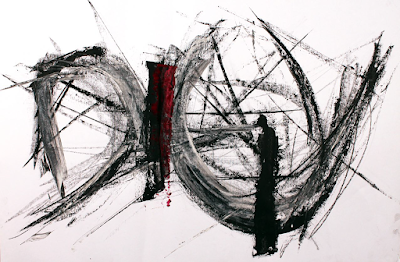Dreams of attachment and those of isolation
By Natalija Paunić
 |
| Photo Nina Ivanović |
Jelena Pantelić is more of a diarist than a storyteller, whose reflections on trust, intimacy and homemaking travel from her personal life into the exhibition space. While this could be said about many artists, what makes her case interesting is the precarious status of cause and effect: there is a difference between things that simply happen and inspire us and those that we do to ourselves to get inspired. The truth is, we don’t always know what comes first, or where it will take us. A way to get a bit of that control back is to bring the darkest and the most peculiar aspects of one’s personal reality to an intentional, artificially and purposefully created exposure; to materialize these issues and show them to an audience; to get an audience and to tell them to deal with it. In this sense, Pantelić experiences her artistic practice as labor rather than work, as a question of necessity rather than choice.
 |
| Photo Nina Ivanović |
This compulsion could, as well, be one possible description of our online presence: don’t we often feel like we need to, rather than want to, spend time on our phones, to be connected to all possibilities at all times, to swipe our way through life? Tavi Meraud taps into this subject while considering touching a liquid-crystal display as touching content and ideas as well, coining a term that pertains very much to Pantelić’s art: “Transintimacy […] includes the love of cyborg love. It includes the love that grows because I survey my love through screens; I can screen myself and project myself, and bask in the glow of the screened image of my love. But I think these are all relatively flat senses of enhancement, compared to the absolutely voluptuous possibilities indicated by the surface. These instances of electronic or techno-love, for lack of a better word, have anyway been considered to be troubling, for these scenarios of contact precisely lack contact, cannot fulfill the haptic injunction decreed upon humanity. Consider transintimacy, then, as an iridescent intimacy, one that is no longer flat contact […], closeness and possession negotiated through touch, but rather a more penetrative possession - possession in that doubled sense of ‘to own’ but to oneself be owned, haunted” (Iridescence, Intimacies, 2015).
 |
| Photo Ivan Zupanc |
The distribution of power between the owner and the owned puts intimacy and transintimacy into a new perspective, one that defines relationships in a sense broader than the one set in the technologically-empowered age that we’re in. Through her work, Jelena Pantelić deals with both: confiding in others and confiding in technology, which ultimately projects from and into self-confidence. A very lucid way to portray relationships is to speak in sexual terms, of fetishes, and of kinks, and to allow for the boundaries to get defined by opposites. This encourages the audience to associate the matters in Pantelić’s art with dichotomies such as sadomasochism, voyeurism, and exhibitionism, which the artist now utilizes even more directly with the title of this exhibition. All the while, however, the question of actual intercourse is left up in the air. As spectators, we’re confronted with an open display of desire, yet we rarely see reciprocity. Even with the video showing two lovers in a parking lot, after having seen the initially exciting but ultimately repetitive kissing in a car, the focus of the viewer shifts from the couple to the person behind the camera (or even more relatively speaking, back to ourselves).
 |
| Photo Ivan Zupanc |
In honesty and vulnerability presented to others, the artist asks for their and our attention, seemingly looking for forms of closeness and bonding, each time anew. This transpires in the way we’re invited into her exhibition, but also in the works themselves and sometimes in their preparation. This experiment in human empathy backfired on many occasions like it did in “Klara”, a video in which we get to know the bizarre ways in which people start conversations with the artist in a chat room. Yet it seems that, in Pantelić’s art, the human potential to disappoint is a “when” and not an “if”, meaning that failure is imminent and also the needed outcome that denounces intimacy and justifies isolation in a cyclic pattern. Perhaps isolation is a defense-mechanism and Tinder and Krstarica are ways to set it in motion when the engines of love inevitably fail. Perhaps love is more self-reflexive than we think it is, perhaps it became such recently, or rather right after people thought it was free in the 70s. Instead of free love, we get to enjoy love with boundaries, but not the kind of boundaries that constrain others. As Pantelić says, we get to have a safeword for ourselves - as in S&M relations, as online, as in life - a protective spell that keeps a portion of one’s intimacy secret.
 |
| Photo Vukašin Đukić |





Comments0
Post a Comment